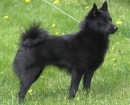The origins of the Schipperke are very old. Already, in documents dating from the late 17TH century refers to a dog whose characteristics described perfectly a copy of Schipperke, She lived primarily with the midwives of the District of Brussels Saint Geey.
It is the typical dog of the shoemakers of the era that, In addition to making shoes used to organize very special dog, Since that most importantly was not the aspect of canine copy but the necklace that had been, manufactured by hand by the shoemakers.
Some authors speak of a legend that, somehow describes a key characteristic of this dog.
Apparently, in one of those dog shows a zapatero not endured defeat and moved by the ira that it caused him to lose in an outburst was and cut off the tail to the winning dog.
However, against all odds the copy of the amputated tail was so successful that thereafter the amputation of the tail began to apply to all copies.
On behalf of the race comes from the Flemish, Schipperke means "small boatman". And the man was given because this dogs accompanied the archers that pass through the channel of Flanders, they were aboard the boats eliminate any small vermin that would cast and also performed guard duties, given that barked furiously to any strange.
At how small it is a dog that brings together many characteristics typical of large breed.
The Schipperke is one of the smallest of Spitz type, with which it shares much similar. In these breeds of medium size look similar to the Schipperke small, in different parts of the world we find the Wolfsspitz (Keeshond), Großspitz, Mittelspitz, Kleinspitz, Zwergspitz (Pomerania), Samoyed, the Elkhound Norwegian, Volpino Italiano, Laïka, Finnish Spitz, India Spitz, Japanese Spitz and the American Eskimo dog.
The Schipperke is recognized for the first time as a breed standard in the year 1880, but was formalized in the year 1889. Much of what is known of their origins and early history comes from Chasse et Pêche, a Frenchman who wrote for the magazine “Hunting and fishing“, articles of which were translated into English and published by the English magazine “The Stockkeeper”.
At first sight, the Schipperke seems a Belgian Shepherd Groenendael miniature.
It is of a small dog, very elegant but well made and muscular. Its quite similar to a Fox head, with the front wide that it is narrowing as close your eyes.
There are two varieties, whose only distinction is the weight. In the smaller of 3 to 5 kg and the largest of 5 to 9 kg.
The snout It is sharp and has a pronounced stop. The ears are small, triangular and slightly separated.
The eyes they are brown in color and rather oval shaped. His characteristic garment consists of a long and very black hair and is completely waterproof. It is significantly longer in the collar area, horsehair, the bodice and back of legs.
The color only recognized by the FCI is the Black zaino. As they grow older, It is normal to be detected small of coloration forming a gray color in places such as the snout.
The puppies are born with tails in different lengths, and in Canada and the United States, the tail is usually being cut the day after birth. In countries that are forbidden to cut off the tail, the Schipperke look natural tail, It falls curved over the back of the dog.
They are curious by nature and overflowing energy, they need enough exercise and good monitoring.
Known for his stubborn temperament, mischievous and stubborn, the Schipperke is defined, times, as the “small black Fox“, the “Black Tasmanian Devil” or the “black devil“.
Proper training is important, because they are very intelligent and independent, and that coupled with the stubbornness… bad combination, they are what gives them the win. They are territorial, and they can not get along with other males.
The Schipperke has no health problems in particular, they tend to live until the 17 or 18 years. However, inactivity, lack of exercise and overnutrition are very harmful, and can lead to problems in the joints, the bones and the conditions of the teeth, heart, lung or digestive system.
The regular weekly brushing is usually sufficient to keep the coat in good condition. No need to cut hair, they tend to move it several times a year (the females, more than males).
The Schipperke, is the ideal companion for lovers of horse-riding, post that usually develops in a natural way a very close relationship between this dog and horses.
It is also the dog ideal for excursions, Despite its small size it is tireless.
- Otros nombres: Spitzke / Spits / Spitske.
- Group 1 / Section 1 – Shepherd dogs.
Dogs breeds: Schipperke














 Schipperke Easy versus tomcat Mako
Schipperke Easy versus tomcat Mako Schipperke puppy Dingo
Schipperke puppy Dingo Yogi – a schipperke's life
Yogi – a schipperke's life schipperke yogi + the crazy swans
schipperke yogi + the crazy swans